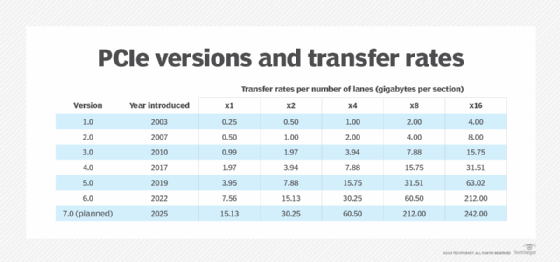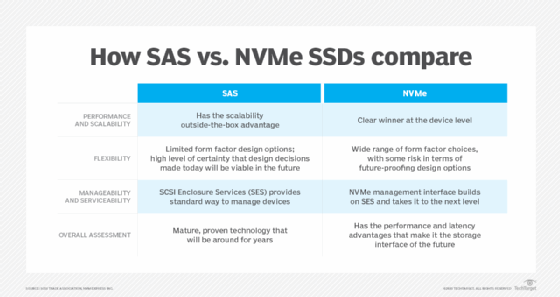SAS SSD (Serial-Attached SCSI solid-state drive)
What is a SAS SSD (Serial-Attached SCSI solid-state drive)?
A SAS SSD (Serial-Attached SCSI solid-state drive) is a NAND flash memory-based storage or caching device designed to fit in the same slot as a hard disk drive (HDD) and use the SAS interface to connect to the host computer.
The most common drive form factors for a SAS SSD are 2.5 inches and 3.5 inches. SAS SSD bandwidth options include 3, 6 and 12 gigabits per second (Gbps). These features make it easy to hot swap drives and ease device provisioning, configuration, maintenance and management.
How are SAS SSDs used?
SAS SSDs are primarily used in enterprise servers and storage arrays with application workloads requiring high availability (HA), high input/output (I/O) and low latency. Use cases for SAS SSDs include server virtualization, online transaction processing, high-performance computing and data analytics.
Drive manufacturers sometimes offer SAS SSDs with different write endurance options. For instance, a high-capacity SAS SSD intended for read-intensive workloads might guarantee only one drive write per day, while a lower-capacity SAS SSD intended for write-intensive workloads might support up to 25 DWPD.
Enterprises usually buy fast and reliable SAS SSDs for higher tiers of data. Serial Advanced Technology Attachment (SATA) drives, with their slower speeds and lower cost per terabyte, are used for capacity and lower-tier storage purposes. While SAS SSDs have traditionally been more expensive than SATA SSDs, the price differences continue to narrow.
SAS SSD vs. SATA SSD
The following are some of the differences between SAS and SATA drives:
- SAS SSDs deliver faster data transfer rates than SATA SSDs.
- They support dual-port operation; SAS generally does not.
- SAS SSDs have built-in features that improve reliability, such as advanced error correction, data integrity technology and high signal quality on the cable or backplane.
- SAS drives use a higher signal voltage than SATA drives and can reliably transmit data -- with better overall data integrity end to end -- at twice the speed of SATA drives.
- Drives using SAS technology, unlike their SATA counterparts, support multiple data paths, superior data path redundancy and HA.
- SATA drives are cheaper, sequentially faster and good for infrequently accessed data.
SAS SSD vs. PCIe
Peripheral Component Interconnect Express (PCIe) is a serial bus expansion standard that enables the attachment of peripherals directly to a computer system. Unlike SAS SSDs, PCIe SSDs, including those based on the emerging non-volatile memory express (NVMe) specification that accelerates performance, integrate flash storage right onto the server motherboard.
Because each PCIe SSD links to a host through its own serial link, the need to share a bus is eliminated, reducing latency and boosting data transfer rates between servers and storage arrays. This enables PCIe SSDs to sidestep the bottlenecks often associated with SAS or SATA SSDs.

SAS SSD vs. nearline SAS
Nearline SAS drives are essentially enterprise-class SATA drives with a SAS connector and fully capable SAS interface command set. They offer many of the advantages of SAS drives -- support for command queuing, concurrent data channels and multiple hosts, for example -- and are slightly faster than SATA drives.
Nearline SAS drives share many SAS characteristics, but they aren't SAS. Instead, they're targeted at network-attached storage servers and store occasionally accessed data that isn't considered mission-critical, which is the opposite of SAS.
SAS vs. NVMe
SAS and NVMe interfaces are two of the most important enterprise storage device standards. Both storage systems deliver high-speed performance, low latency, flexible scalability and maintainability. The more recent NVMe standard delivers greater performance than SAS, but both are in widespread use. SAS SSDs that deliver multiple gigabit per second throughput surpass the performance of HDDs configured for SAS. The SAS architecture supports the creation of large data storage arrays, but this arrangement can compromise storage controller performance.
By contrast, the NVMe standard is designed for SSDs, which have inherently faster performance and lower latency than HDDs. NVMe SSDs use the PCIe bus, which provides multiple channels for data movement. Costs associated with NVMe technology can be greater than for SAS storage, especially when large data sets are being managed. NVMe SSDs also can support multiple form factors, such as Add-In Card/Card Electromechanical, M.2 and U.2. The form factor used depends on the application and system compatibility.

Pros and cons of SAS SSDs
SAS SSDs are fast, at up to 12 Gbps, and require little hardware overhead. The latter is important when it comes to maximizing I/O operations per second, or IOPS, and reducing data latency. They deliver a high level of end-to-end data integrity and include features such as error correction to improve reliability.
SAS drives come in a variety of endurance options, depending on the manufacturer, to match particular workload and write requirements. Support for multiple data paths makes for higher levels of performance and availability, while also enabling data path redundancy.
SAS SSDs are all about performance and reliability. Organizations don't buy these drives purely for storage capacity purposes. SAS SSDs are pricier than their SATA counterparts, but they're less expensive than comparable NVMe storage devices.
The future of SAS SSDs
SAS SSDs use the SAS 4.0 (SAS-4) specification, which increases the full throughput per lane to 24 Gbps. The actual maximum throughput is 22.5 Gbps, a significant jump over the 12 Gbps maximum bandwidth for SAS 3.0.
Version 4.0 of the specification is composed of two parts: the SAS-4 physical layer and SAS Protocol Layer-4. A 45 Gbps version, called SAS 5.0, has been rumored since 2018 but hasn't been released.
A new version of SAS, called Value SAS (vSAS), is gaining attention as it presents a cost-effective migration path for SATA SSDs. New SSDs with the vSAS standard can deliver storage capacities similar to SATA drives, better performance, security and reliability, with pricing comparable to SATA drives.
Competition with NVMe for enterprise storage will continue, with both SAS and NVMe storage architectures providing cost-effective enterprise-level storage solutions. NVMe will occupy the top tier, delivering more storage capacity and better overall performance.
Storage technology is rapidly changing. Get the latest on flash storage, the rise of NVMe, much denser formats such as quad-level cell and the all-flash data center.







